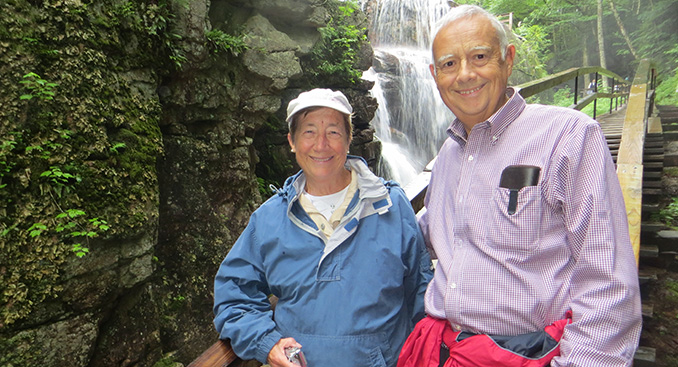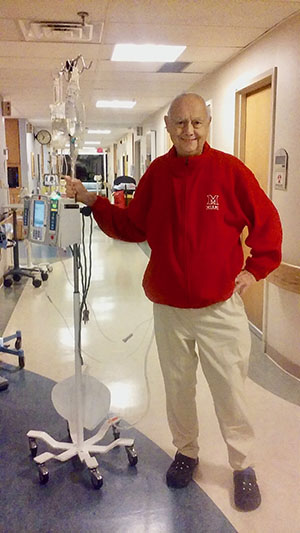- Community & News
- Service Line
David’s story: Central Nervous System Lymphoma

The neurophysiologist took stock of his neurological symptoms. Last September, while on a visit to Washington, he emerged from a tour of the Supreme Court and noticed a weather change. “It was no big deal, except that my right arm felt so different than my left arm,” recalls David Wilson, PhD, a retired professor of zoology at Miami University. “It felt as if it was being pelted by ice or sleet. And yet I knew it couldn’t be.”
The sensation abated, but others followed.
He experienced numbness in his hand. He wondered whether he had carpel tunnel. The numbness spread to his elbow. Could it be a pinched nerve? He saw his primary care physician, who scheduled a CT scan. Then, while working in his yard, Dr. Wilson felt the numbness spread up to his neck and face. “It scared me,” he says. “I thought I might be having a stroke.”
Dr. Wilson’s wife, Susan, drove him to the emergency room at TriHealth McCullough-Hyde Memorial Hospital in Oxford. The symptoms vanished, and he told the emergency room doctor that he needed to leave because he was expected at a function for a Miami institution partially named in his honor, the Thomas H. Mallory and David F. Wilson Center for Healthcare Education.
“It’s obviously a pinched nerve,” he told the doctor, Nicole White MD.
“It doesn’t look as though you had a stroke,” she agreed. “Nevertheless, you thought you had a stroke, so we at least need to do a CT scan to make sure.”
Dr. Wilson would later commend Dr. White for her thoroughness. Not even he, the neurophysiologist, could see what was coming. The CT scan revealed “something” in his brain, and an MRI was immediately ordered.
Edward Crane MD, a medical oncologist with the TriHealth Cancer & Blood Institute, was working at McCullough-Hyde that afternoon. After analyzing the MRI, he made a preliminary diagnosis – brain cancer – and referred Dr. Wilson to Mayfield Brain & Spine for a biopsy. An hour after a diagnosis of probable brain cancer, Dr. Wilson headed over to Miami’s Goggin Ice Center for the Mallory-Wilson function. Said Dr. Wilson, “What else am I going to do?”
Getting the Diagnosis Right
 In cancer care, an accurate diagnosis is the best springboard to survival. An accurate diagnosis means optimal treatment, including personalized targeting of the cancer variant. The care of Dr. Wilson, a beloved teacher who had mentored pre-med students for 40 years, was now in the hands of Dale Horne, MD, PhD, a neurosurgeon with Mayfield and the TriHealth Neuroscience Institute who performs surgery at TriHealth Bethesda North Hospital. Dr. Horne knew the importance of what he was called upon to do.
In cancer care, an accurate diagnosis is the best springboard to survival. An accurate diagnosis means optimal treatment, including personalized targeting of the cancer variant. The care of Dr. Wilson, a beloved teacher who had mentored pre-med students for 40 years, was now in the hands of Dale Horne, MD, PhD, a neurosurgeon with Mayfield and the TriHealth Neuroscience Institute who performs surgery at TriHealth Bethesda North Hospital. Dr. Horne knew the importance of what he was called upon to do.
“Dr. Wilson had an unusual appearing lesion,” Dr. Horne says. “He had been prescribed steroids prior to my involvement and, although he had just stopped them, they had had an effect. The morning of his surgery, we did a stereotactic scan. I had planned to do a needle biopsy, which I initially thought was the safest course. During a needle biopsy, we drill a small hole in the skull and use a narrow, hollow needle to remove a tissue sample from the tumor. But the scan showed that the enhancement was significantly less than what it had been. In other words, the contours of the tumor were smaller and less distinct than in the initial scan.
“Steroids cause the cells within the center of lymphomas to die,” Dr. Horne explains. “They never kill all the cells, but they make it more difficult to diagnose. In this situation a needle biopsy would increase the risk of surgery and lower the chance of making an accurate diagnosis.”
Dr. Horne changed his approach to an open biopsy. He would now open the skull in a craniotomy, expose the tumor, and extract a tissue sample that a neuropathologist would examine.
“I went and talked to Dr. Wilson,” Dr. Horne says. “I told him it was better to convert the case to an open craniotomy. I didn’t want to end up with a negative needle biopsy and have to go back and do a second procedure.”
Dr. Horne made a one-inch craniotomy, and the procedure was a success. The diagnosis came back as a central nervous system lymphoma, a fast-growing cancer whose cells form in the brain’s lymph tissue. Because the incision was small, Dr. Wilson was able to start chemotherapy the next week.
Dr. Wilson praised Dr. Horne during one of his week-long treatments at TriHealh Good Samaritan Hospital. “Dr. Horne wanted to make sure he got a good sample,” Dr. Wilson says. “He had the room all set up and prepared to do a needle biopsy, and he looked at the MRI scan that morning and said, ‘I don’t trust it because the tumor had started to diffuse.’ It wasn’t as distinct as it was in the prior study.
“He also knew there were a lot of blood vessels on the surface of the brain in that area, and he was afraid they could cause a brain bleed, which could cause a stroke. So I think he made an incredibly good decision to do a craniotomy. He was able to get in there and push around the blood vessels without causing a bleed and was happy with the tissue sample.”
Once Dr. Wilson concludes his basic chemotherapy, he may receive a more targeted therapy for his cancer, a large, non-Hodgkin B-cell type that rarely spreads outside the nervous system.
Dr. Wilson is also grateful for the care provided by his three TriHealth hospitals. “I’m convinced that I’m getting the best possible care,” he says. “I’m at a wonderful center. I have a wonderful team of doctors. I love the fact that the physicians are talking to each other.”
Dr. Wilson, a Presbyterian who maintains his theological independence, adds that he finds solace in the symbols of Christ that pervade Good Samaritan Hospital. “It’s very comforting,” he says. “Everyone I’ve met here, I swear they are trying to be The Good Samaritan. You couldn’t ask for better.”
-- Cindy Starr, Mayfield Brain & Spine
Related Articles
- Community & News
- Service Line
- Community & News
- Heart
- Patient Stories
- Service Line